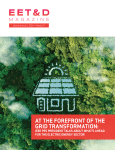
Four years ago, we featured a conversation with Shay Bahramirad, Ph.D. about the role IEEE PES plays in collaborating with utilities and energy consumers. At the time, Bahramirad was with ComEd and served as IEEE PES vice president of new initiatives and outreach. Today, Bahamarid is senior vice president of engineering, asset management and capital programs at LUMA Energy, the power company responsible for electric service in Puerto Rico. She also has just assumed the helm as president of IEEE PES.
While attending a conference this past fall, EET&D Publisher Steven Desrochers had a chance to speak with Dr. Bahramirad about LUMA Energy’s progress since taking over as the utility in Puerto Rico, as well as her vision for her term as the leader of IEEE PES. In our Grid Transformation Forum section of this issue, we feature the conversation between Desrochers and Bahramirad.
According to Bahramirad, when LUMA stepped in as the grid operator for Puerto Rico in 2021, the reliability of the system was 300% worse than the worst utility in the U.S. Since then, LUMA has initiated 411 FEMA projects that represent 11.7 billion dollars of investment.
While Bahramirad remains focused on her work for LUMA, she is also excited about what she will be doing on behalf of IEEE PES and the electric energy sector in general. Because she has lived in the Middle East, Europe, the U.S., and now, Puerto Rico, Bahramirad has a broad view of the industry landscape, and she looks forward to using her experience and insight to continue moving the industry forward.
As she assumes her role for IEEE PES, Bahramirad talks about where the industry is headed, the challenges like climate change and grid modernization that the industry continues to face and the critical role industry partners must play to implement the best solutions to address those challenges.
Bahramirad is one of several contributors to this issue to address the numerous challenges that the electric energy industry will continue to face in 2024. Also writing about some of the ongoing challenges plaguing our industry are James Street with Epoch Solutions Group, Brian Rock with Bentley Systems, Richard Harada and John Nam with Systems With Intelligence and Brian Berry with Ampacimon.
Two additional contributors writing about obstacles within the power sector are Koustuv Ghoshal with Ericsson and Mishal Thadani with Rhizome. I wanted to spotlight their articles here because I appreciate the unique approach each has taken to identify those hurdles.
In his article, “Utilities need to decarbonize, decentralize and digitalize,” Ghoshal notes that the grid is becoming more complex as more utilities charge towards meeting their Net Zero goals. Ghoshal suggests that there is potential for the communications and power grid sectors to collaborate in addressing these challenges head-on. According to Ghoshal, telecom networks is an untapped tool for creating intelligent networks to manage this increased complexity while also reducing carbon footprints.
As Ghoshal explains, “Mission-critical cellular networks providing grid connectivity can become that grid modernization mechanism that provides resiliency and flexibility for an evolving grid while reducing carbon emissions.” Ghoshal believes that through their collaboration, the communications and power grid sectors can ensure that during an emergency, no one is left vulnerable without power or connectivity.
Rhizome CEO Mishal Thadani talks about the challenge of an aging electricity grid in “A health screen for the grid challenges of an aging grid,” and compares the grid’s infrastructure to that of the human musculoskeletal system.
As we get older, our bodies take longer to recover from illness or trauma. Over time, if we have not maintained a good diet, or taken proper care of our minds and bodies, we aren’t likely to recover well, if at all. If we take care of ourselves and adjust our activity, diet and lifestyles throughout our lives, we stand a better chance of having stronger bones and maintaining better health as we age.
Thidani points out that for the electric grid, the more frequently natural or human-made disasters strike, the more damage they will cause to the electric grid. If the infrastructure of the grid is not maintained, the chances for it to recover quickly from any of these disasters decrease significantly. And just as it is wise to map out a treatment plan to address our health issues – especially as our bodies age and it takes longer for us to recover from from debilitating illnesses or accidents, it also is wise to create a treatment plan for an aging grid in preparation for existing and new climate threats. Thidani walks our readers through several steps – like projecting climate data, diagnosing the symptoms of climate change, measuring the damage, and designing a “treatment plan” that will lead to a healthier future for the energy grid.
It is impossible to know every challenge or hurdle nature or climate change has in store for the electric grid, but as our industry partners writing for this issue remind us, we have a better chance of overcoming these challenges if we acknowledge those challenges exist and remain proactive and prepared to tackle them when they strike.
As always, if you would like to contribute an article on an interesting project, please email me: Elisabeth@ElectricEnergyOnline.com
Elisabeth






